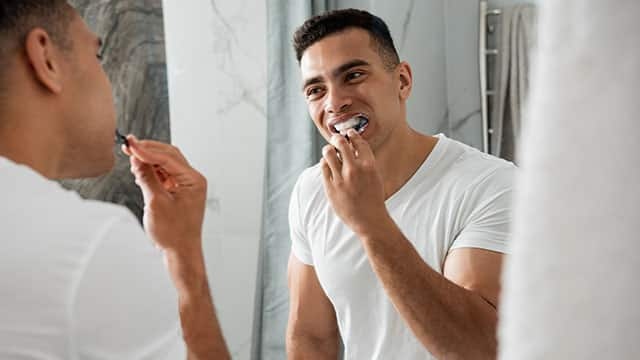1. Genetics
Sometimes, tooth color runs in the family. If one of your parents' teeth are yellow, it's likely that yours are a similar hue. Reddish brown, reddish yellow, gray and reddish gray are the four natural shades of otherwise white teeth, and this depth of color varies across a spectrum from light to dark.
2. Dentin
Teeth look yellow when the enamel is thin and the dentin underneath shows through it. Dentin is a deep yellow to brownish material inside your teeth under the enamel, and it's often responsible for the yellow you see when you look in the mirror. Thick enamel covers up the dentin, but keep in mind it doesn't always block the stains that build up on the surface, another cause of yellow explained further down.
3. Wear
Teeth ultimately turn yellow as you get older, when enamel wears away from chewing and exposure to acids from food and drink. Most teeth turn yellow as this enamel thins with age, but some take on a grayish shade when mixed with a lasting food stain.
4. Smoking
Nicotine from smoking doesn't just develop an unhealthy addiction; it leaves yellowish or brownish surface stains on your teeth, too (one more reason to kick the habit).
5. Foods
A wide range of foods stain teeth. Tomatoes in pasta sauce, curry spices and berries all contain pigments that cling to tooth enamel and stain this surface. Even a healthy salad with balsamic vinegar dressing can leave an unsightly color on your teeth.
6. Drinks
Coffee and tea are two of the most common causes of yellow teeth, but red and white wine are also to blame. Other culprits include dark and light sodas and sports drinks with artificial flavoring.
7. Antibiotics
Tetracycline antibiotics stain teeth when they're developing in the gums. According to the National Intitutes of Health, if your mother took antibiotics in the second half of her pregnancy, or you took them before the age of eight, you may have permanently stained adult teeth that merit an in-office bleaching treatment.
8. Fluorosis
Fluoride is good for teeth, but excess fluoride can cause yellow or brownish yellow spots called fluorosis. Fluoridated water, fluoride toothpaste and prescribed fluoride tablets and treatments are your biggest sources of fluoride. Ask your dentist if you're concerned you or your child is taking too much through these means.
9. Accidents
Impact of an accident or physical trauma can crack tooth enamel and damage the tooth's interior, leading to discoloration that may indicate bleeding that needs professional attention.
10. Grinding
Tooth grinding is an unconscious habit some people have when they're stressed, especially while asleep. Also known as bruxism, it's quite harmful to tooth enamel, weakening it to the point of cracking and yellowing.
Oral Care Center articles are reviewed by an oral health medical professional. This information is for educational purposes only. This content is not intended to be a substitute for professional medical advice, diagnosis or treatment. Always seek the advice of your dentist, physician or other qualified healthcare provider.
ORAL HEALTH QUIZ
What's behind your smile?
Take our Oral Health assessment to get the most from your oral care routine
ORAL HEALTH QUIZ
What's behind your smile?
Take our Oral Health assessment to get the most from your oral care routine















